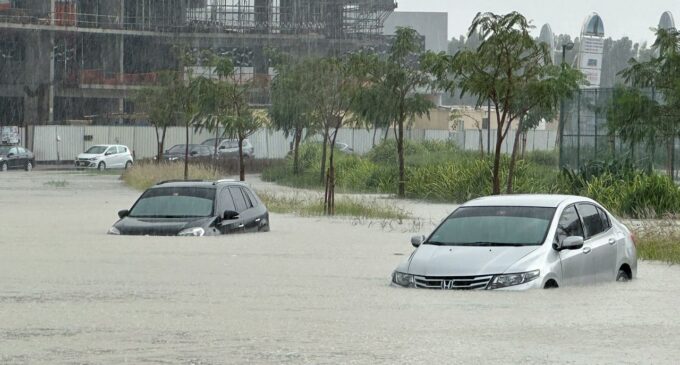Several posts on social media have claimed that the torrential rainfall that recently ravaged the United Arab Emirates (UAE) was caused by cloud seeding.
The claim, seen on X, Facebook, and Instagram, suggested that the UAE was reaping the reward of artificially induced rain.
RECORD-BREAKING RAIN IN DUBAI
On April 17, parts of Dubai were submerged due to one year’s worth of rainfall, causing heavy floods and vehicles to be abandoned on the highway.
The rainfall disrupted airport operations and was linked to the deaths of about 19 persons in Oman, while two persons were declared missing.
Dubai is one of the seven emirates of the UAE. As a desert city, it has a year-round hot climate.
The UAE has an arid desert climate with two major seasons —winter and summer. During the summer season (June to September), the temperature is extremely high and can be expected to rise to 50°C. The winter season (December to March) has temperatures ranging from 16.4°C to 24°C, with January being the coldest month.
Since 1949, when the country began recording climate, experts said this is the first time UAE has experienced such dimension of rain and flood.
The country’s National Center of Meteorology said the rain contributed significantly to an increase in the country’s annual average rainfall and helped bolster the country’s groundwater reserves.
WHAT IS CLOUD SEEDING
Cloud seeding is a form of weather modification that implants a special kind of salt in the cloud to produce more rain. Countries in the desert or drought-prone areas like the UAE sometimes engage in cloud seeding to make rain.
The processes commence with the identification of suitable clouds through weather monitoring and analysis to produce the best outcome, and timing the rain to determine when it is most needed. An aircraft loaded with a seeding agent on its wings is then sent to the nearest cloud to create more water droplets. These droplets subsequently merge and fall as rain.
Seeding agents include salts like silver iodide, potassium iodide, sodium chloride, or dry ice (solid carbon dioxide)
However, in a natural cause, rain is produced when water molecules evaporate into the cloud through a process called evaporation. It is then converted from its gaseous state to liquid, usually, through a process known as condensation. When these water droplets get too heavy to stay suspended in the cloud they fall as rain— precipitation.
CAN CLOUD SEEDING PRODUCE SUCH VOLUME OF RAIN?
As much as cloud seeding is known to enhance rainfall, scientists say it cannot create clouds from anything.
While normal rainfall is said to be between 2.5 mm per hour and 7.5mm per hour, UAE’s highest annual rainfall was 147.53 mm in 1976, which is 57.53 mm higher than Wednesday’s rain. A normal year has an annual rainfall of about 59.73.
In an interview with GB News, Maarten Ambaum, a meteorologist at the University of Reading, said the UAE does not have the operational cloud seeding programme to enhance the nature of rain that was seen on April 17.
He also said there was no cloud seeding operation recently done by the country, as the cloud had been predicted to produce a substantial amount of rain.
“The UAE does have an operational cloud seeding programme to enhance the rainfall in this arid part of the world, however, there is no technology in existence that can create or even severely modify this kind of rainfall event. Furthermore, no cloud seeding operations have taken place in this area recently,” Ambaum said.
“Cloud seeding, as its name suggests, generally involves spreading fine particles into existing clouds into which conditions of wind, moisture and dust are insufficient to lead to rain. In this particular case, there would have been no benefit to seed these clouds as they were predicted to produce substantial rain anyway.
“It’s also worth noting that forecasters, including the Global Flood Awareness System (Glofas) which is run by the European Commission as part of the Copernicus programme, were very accurately forecasting a high risk of floods across a wide area of the region a full week ago. Forecasting systems such as this use detailed observations of conditions in the sea, air and land, and combine them in forecast models to predict future flood events. If these models were predicting that floods were highly likely a week ago, it’s unlikely that humans could do much about it, other than prepare themselves to get out of the way.”
VERIFYING THE CLAIM
TheCable reached out to Taiwo Ogunwumi, a flood risk consultant at Geohazard Risk Mapping Initiative, to find out the reason behind the torrential rainfall in Dubai. Ogunwunmi said the rain could be attributed to greenhouse emissions caused by human activities.
He said though cloud seeding can cause pluvial flood — when the amount of rainfall exceeds the capacity the ground can absorb — the April 17 downpour cannot be outrightly attributed to cloud seeding since it was forecasted to rain that day.
“On a general note, cloud seeding can lead to pluvial flooding, as we all know that the major objective of cloud seedings is to artificially produce more rainfall for areas that constantly experience drought or low rainfall patterns,” Ogunwumi said.
“In the case of the Dubai flood, we can’t categorically attribute the cause of the flood to cloud seedling, simply because forecast already predicted the changes in rainfall amount ahead of the day of this flood occurrence, and some of this climate change forecast excludes cloud seeding factors.
“The human contribution through greenhouse gas emissions will continue to make the climate warm and will subsequently cause increasing rainfall amount. The latest IPCC report further underscores the likelihood of significant changes in climate dynamics. It will be more advisable we don’t use the cloud seeding factor as a narration to deviate from the real cause of climate change impacts.”
Also weighing in, Gloria Okafor, a lecturer at the department of meteorology and climate change, Nigerian Maritime University, Delta state, said the UAE rain was beyond cloud seeding.
Okafor linked the rain to scientists’ prediction of the world’s transition into the El Nino period.
“I will say weather is unpredictable, though cloud seeding produces rain, but this was quite much,” Okafor said.
“However, I am to link this to scientists inferring this year as currently El Nino period —this is when you have more than normal above-sea surface temperature increase from the Pacific Ocean, that has impact on global climate patterns. That I can say makes it possible.”
According to a study published by ResearchGate, El Niño is a climate pattern that describes the unusual warming of surface waters in the eastern Pacific Ocean. During an El Niño event, westward-blowing trade winds weaken along the equator. These changes in air pressure and wind speed cause warm surface water to move eastward along the equator, from the western Pacific to the coast of northern South America.
VERDICT
There is insufficient evidence to support the claim that cloud seeding caused the flood.





